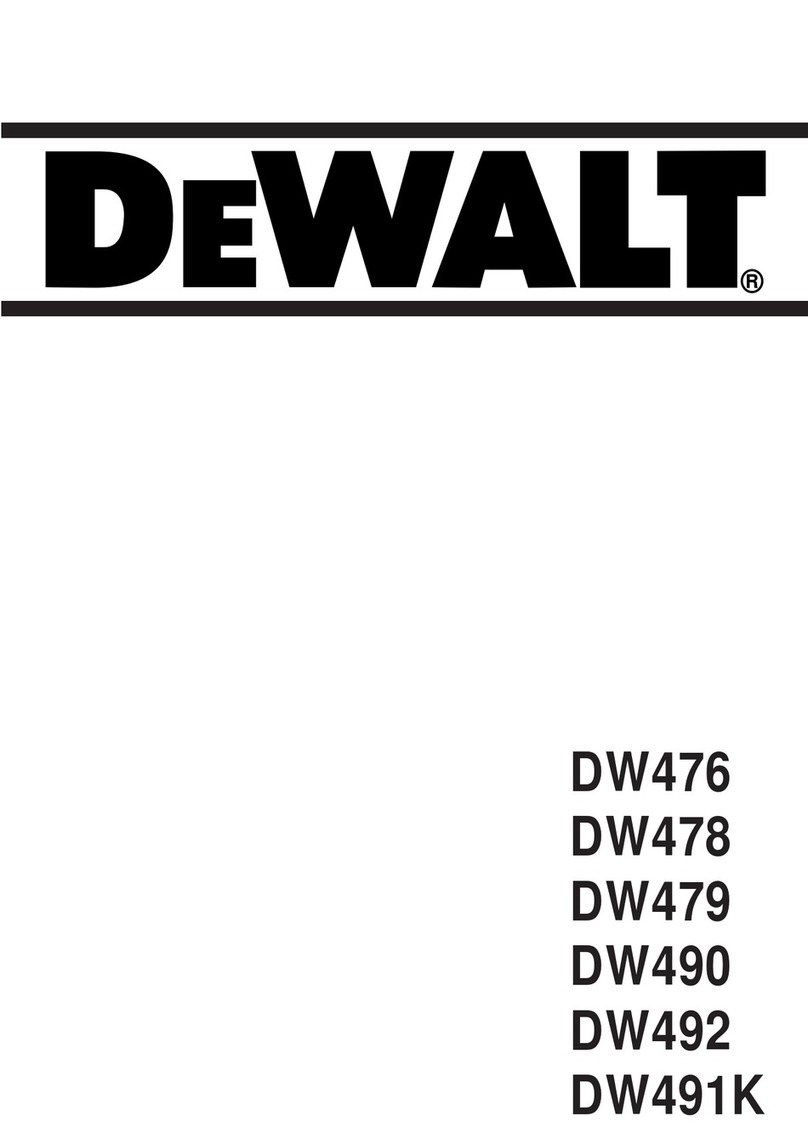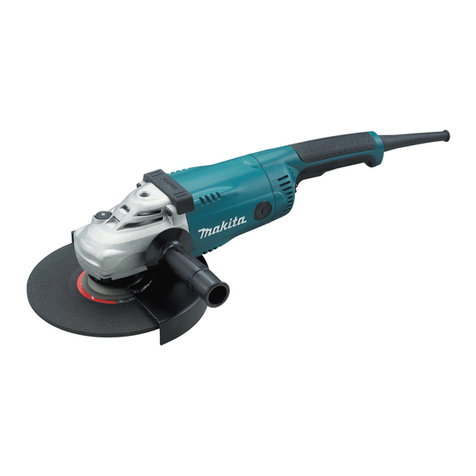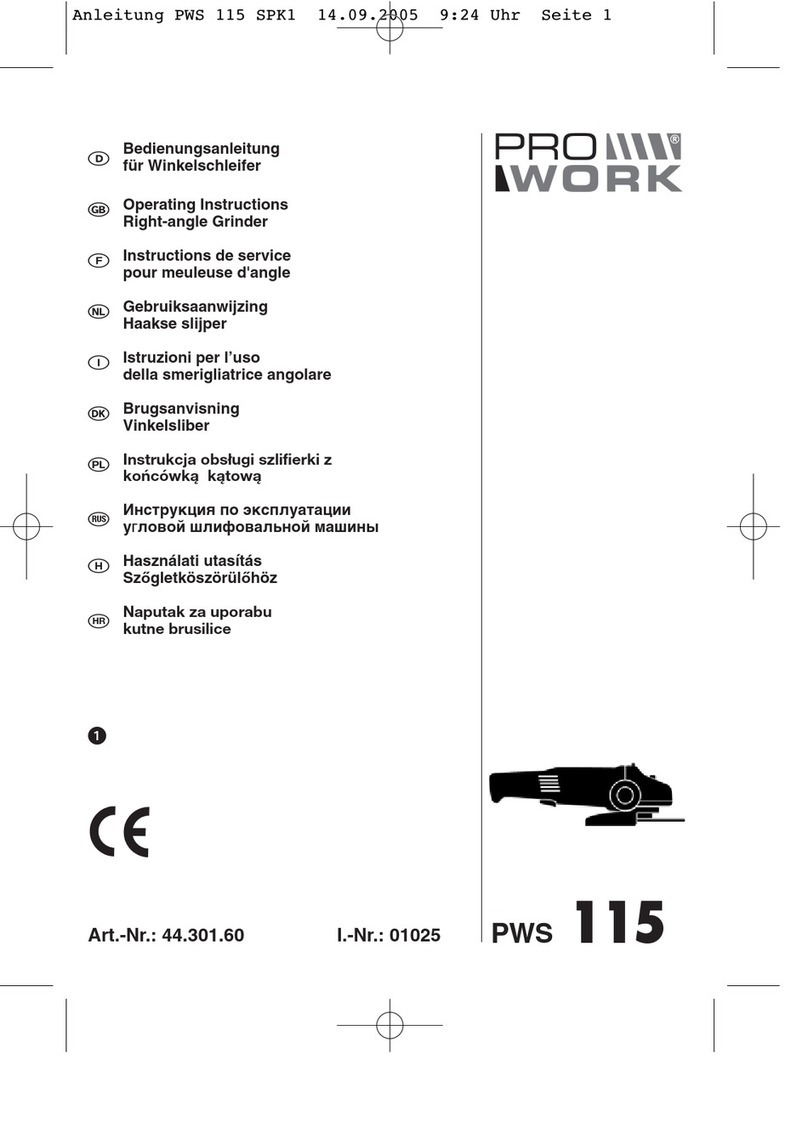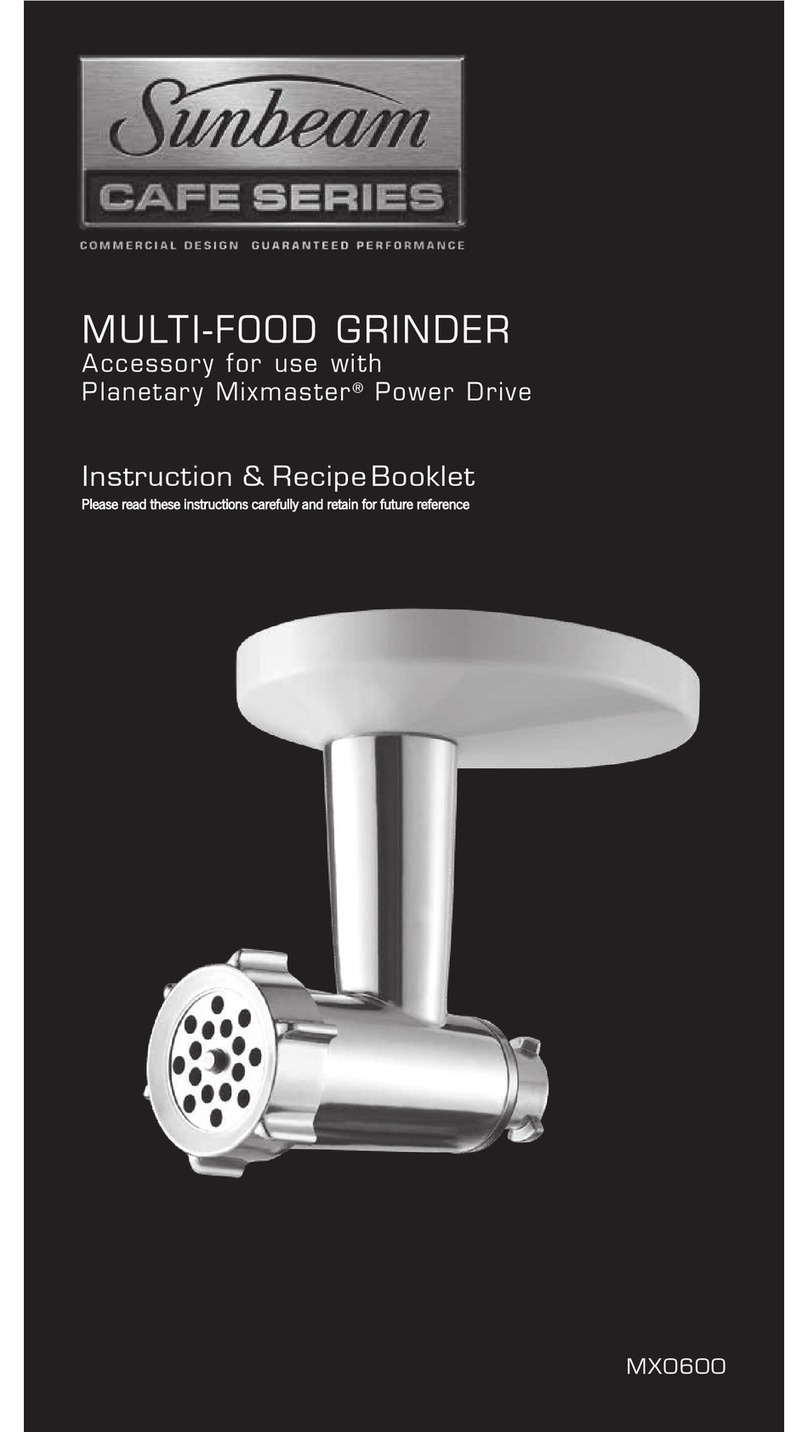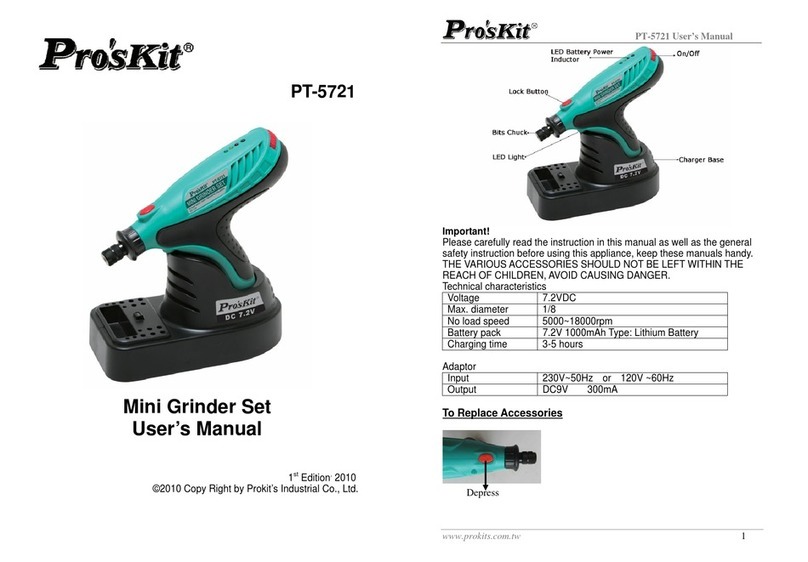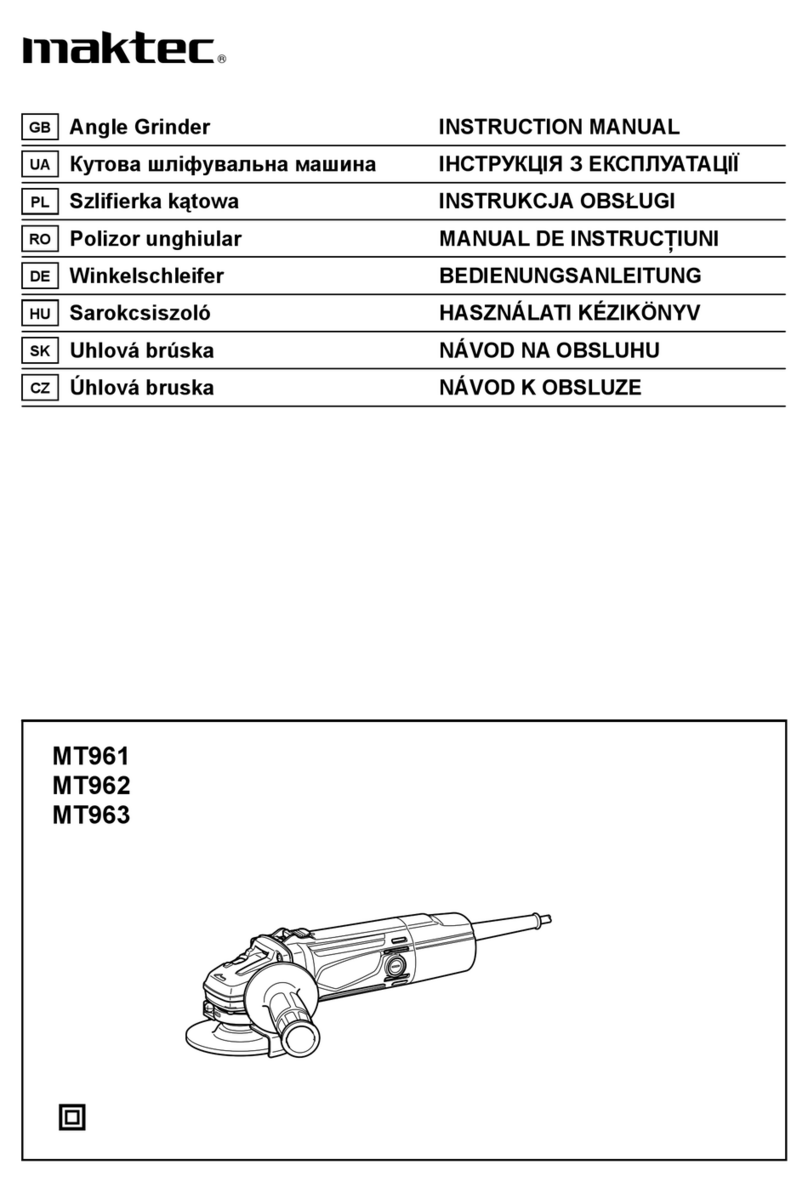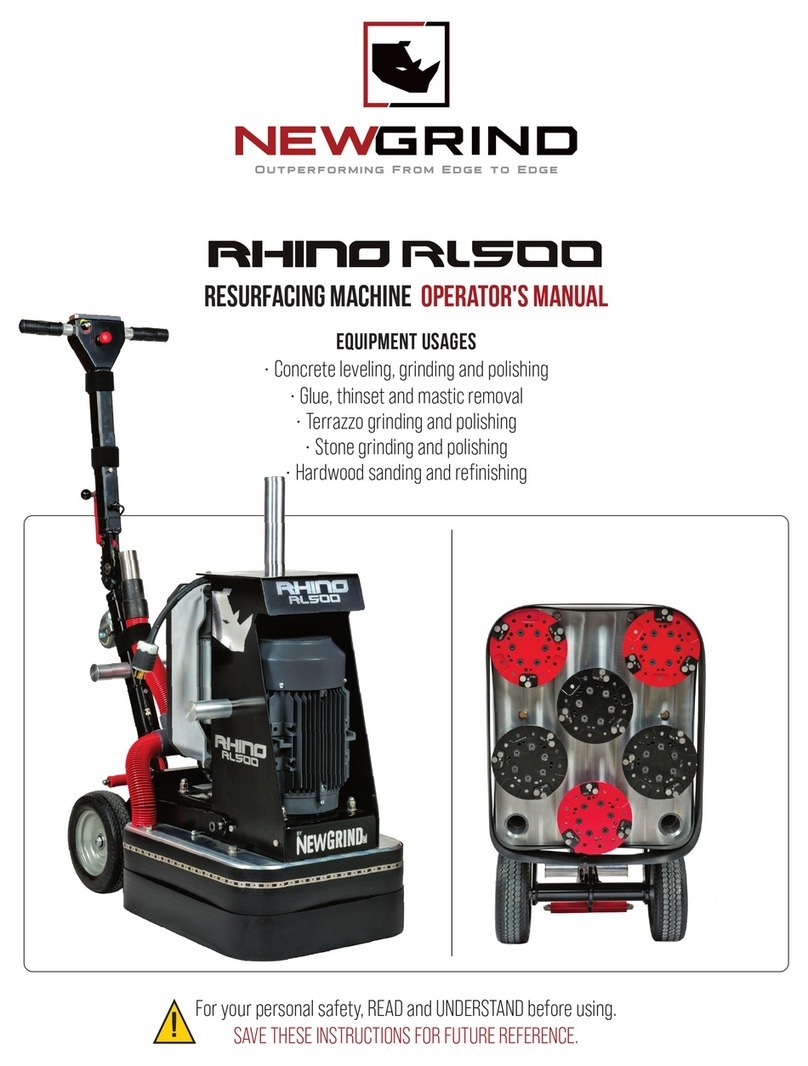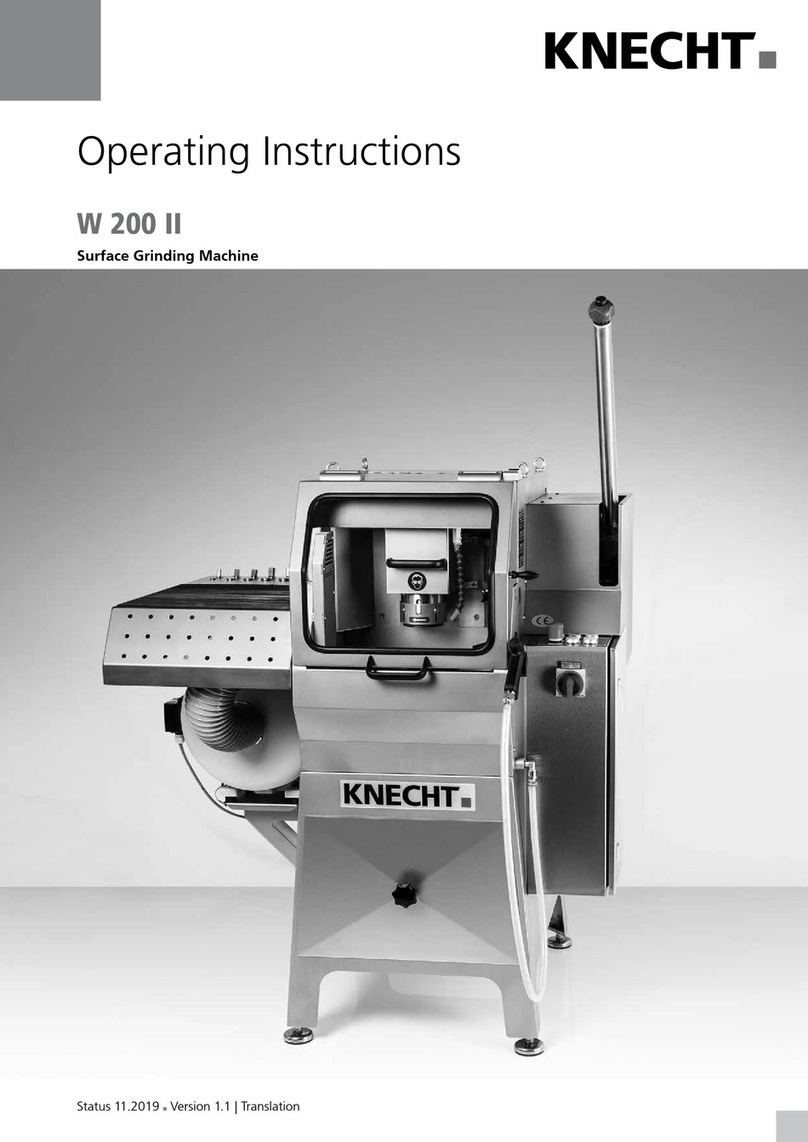ROBEL ROGRIND P4 190 SWITCH 2.0 User manual

Co
ntent
1
OPERATING MANUAL
ROGRIND P4 190 SWITCH 2.0
Rail and switch grinding machine

2
Robel Bahnbaumaschinen GmbH
Industriestraße 31
83395 Freilassing
Phone: +49 (0)86 54 609-0
Fax: +49 (0)86 54 609-445
E-Mail: info@robel.com
Web: www.robel.com
Translation of original operating manual
Status: 27.02.2019
Version: V2
© 2019 Robel Bahnbaumaschinen GmbH
These operating instructions were produced in accordance with the
current state of technology at the time of printing.
The right to change on the basis of further developments is reserved.
Dimensions and weights are approximated.
Photographs show special layouts in some cases.

3
Content
Content
1. General Information..................................................................................................................... 6
1.1 About these instructions................................................... 6
1.2 General Regulations.......................................................... 6
1.3 Intended audience for this Operating Manual.................7
1.4 Liability Exclusions.............................................................7
1.5 Copyright.............................................................................8
1.6 Acceptance, Equipment and Operating Licence.............8
1.7 Validity of these instructions.............................................8
2. Safety.............................................................................................................................................9
2.1 Designated use.................................................................. 9
2.2 Foreseeable misuse...........................................................9
2.3 Conventions of layout......................................................10
2.4 Design changes, original parts....................................... 10
2.5 Protective devices............................................................11
2.6 Safety regulations............................................................11
2.7 Qualifications of staff......................................................12
2.8 Personal protective equipment......................................12
2.9 Information on particular types of dangers.................. 13
2.10 Accident prevention.........................................................17
2.11 Fire safety.........................................................................18
3. Technical data............................................................................................................................ 19
3.1 Drive..................................................................................19
3.2 Grinding spindle...............................................................19
3.3 Dimensions...................................................................... 19
3.4 Filling quantities.............................................................. 19
3.5 Weight.............................................................................. 19
3.6 Abrasives.......................................................................... 20
3.6.1 For rail head widths up to 75 mm..................................20
3.6.2 For rail head widths up to 120 mm............................... 20
3.6.3 Cup wheel for frog noses (optional)............................... 20
3.7 Plunging depth.................................................................20
3.8 Digital tach/hour meter.................................................. 20
3.9.1 Noise emissions...............................................................21
3.9.2 Vibration........................................................................... 21
3.10 Environmental conditions............................................... 21
3.11 Structure gauge............................................................... 21

4
Content
4. Description of machine..............................................................................................................22
4.1 Structure...........................................................................22
4.2 Design variants................................................................ 23
4.3 Control elements............................................................. 24
4.3.1 Machine............................................................................24
4.3.2 Engine...............................................................................24
4.4 Accessory (to order).........................................................25
4.4.1 Abrasives, steel brushes................................................. 25
4.4.2 Tool box............................................................................ 26
4.5 Field of application..........................................................26
4.5.1 Necessary/optional equipment..................................... 27
4.6 Signs and Labels..............................................................27
4.6.1 Signs and Labels used.................................................... 27
4.6.2 Position on the product...................................................29
4.7 Digital tach/hour meter.................................................. 30
4.8 Workplace........................................................................ 30
4.9 Structural gauge.............................................................. 30
5. Operating conditions..................................................................................................................31
5.1 Operation..........................................................................31
5.2 Storage............................................................................. 31
5.3 Transport.......................................................................... 32
6. Commissioning...........................................................................................................................33
6.1 Digital inductive tach/hour meter..................................33
6.1.1 Operation..........................................................................33
6.1.2 Settings.............................................................................34
6.2 Re-railing.......................................................................... 35
6.2.1 Machine without dead man’s brake.............................. 35
6.2.2 Machine with dead man’s brake (Option)..................... 35
6.2.3 Putting the machine on the rails....................................35
6.3 Checking the machine.................................................... 37
6.3.1 Abrasive and grinding spindle........................................ 37
6.3.2 Engine...............................................................................37
6.4 Starting the engine..........................................................41
6.4.1 Cold start.......................................................................... 43
6.4.2 Warm start....................................................................... 45
6.5 Test run.............................................................................45
6.6 Working with the machine..............................................46
6.6.1 Basic approach grinding................................................. 46
6.6.2 Positioning the grinding spindle.....................................46
6.6.3 Tilting the grinding spindle............................................. 47
6.6.4 Grinding spindle infeed................................................... 48
6.6.5 Grinding with reciprocating movement.........................48
6.7 Switching off the engine................................................. 48
6.8 Unrailing the machine..................................................... 50
6.8.1 Standard procedure.........................................................50

Content
5
6.8.2 Emergency procedure 50
7. Maintenance............................................................................................................................... 51
7.1 Maintenance schedule.................................................... 52
7.1.1 Engine...............................................................................52
7.1.2 Machine............................................................................ 53
7.2 Engine...............................................................................53
7.2.1 Checking the oil level...................................................... 54
7.2.2 Changing the oil...............................................................55
7.2.3 Maintaining the air filter................................................. 59
7.2.4 Maintaining the spark plug............................................. 61
7.3 Lubricate.......................................................................... 63
7.4 Changing the abrasive.................................................... 63
7.5 Check signs and labels................................................... 65
7.6 Cleaning and care............................................................65
8. Troubleshooting..........................................................................................................................66

1. General Information
6
9.
1.
General Information
1.1 About these instructions
Staff operating and maintaining this product must have read
and understood these operating instructions.
All those involved must have access to the operating instruc-
tions at all times.
1.2 General Regulations
The following symbols are used to mark operating procedures,
lists and other elements of these instructions:
Symbol
Explanation
1. Action
2. Action
Operating procedure - the se-
quence of actions must not be
changed.
List 1
–List 1.1
List 2
List- Sequence may be
changed.
►Measure
►Measure
Measure - the sequence must
not be changed.
Appropriate legal requirements and accident prevention
measures for use of this product must generally be observed. If
they are not observed, the operator of the appliance takes re-
sponsibility for any legal consequences.
In the event of differences between prevailing regulations that
apply to use of the product and the manufacturer’s or sub-
contractor’s specifications, whichever limitations are the most
stringent must apply.
The buyer must provide all necessary machinery, equipment
and material resources for putting the delivered product into
operation and training staff. He must also make available un-
restricted, safe and sufficiently long track and work sections,
on which staff can learn how to operate and use the delivered
product and practise these tasks. Since the manufacturer or
supplier of the product has no influence over the buyer’s par-
ticular staffing and operating circumstances, no responsibility
is accepted for the effectiveness of the instructions.
ROBEL Bahnbaumaschinen GmbH together with its customer
service organizations are however happy to provide further
advice, training or other consultative services. Further details
and conditions can be obtained separately.

7
1. General Information
1.3 Intended audience for this Operating Manual
1.4 Liability Exclusions
This manual contains the information needed to use the prod-
uct they describe correctly.
The manual has been written exclusively for technically quali-
fied personnel. Qualified personnel in this context are:
Personnel who can prove that they are qualified to use this
product either through training or experience,
Personnel familiar with the safety concepts that relate to
machinery and equipment,
Maintenance and service personnel who are specially
trained to repair machines, appliances and itsaccessories.
Only persons who can read and understand this manual are
allowed to use the product. They should sign to indicate that
they have read and understood the manual.
Replacement, maintenance and operation of the product
should only occur where official regulations are strictly fol-
lowed for its use and safety, especially where they relate to
safety and protection of the workplace and environment as
well as the operating, maintenance and safety regulations or
other instructions supplied by the manufacturer or supplier.
The manufacturer declares himself to be exempt from any
responsibility for damage arising when the product is not used
in a designated way. This also includes use of the machine
without safety mechanisms.
Any use of the product other than that specified above is not
designated and endangers the lives and health of operating
and maintenance personnel as well as the material property of
the operator. The manufacturer of the product declareshimself
free from liability for damage to people or property belonging
to the operator or a third party if:
the product is not used as specified,
operating and maintenance personnel have not read and
understood the aforementioned directions and have used
the product for other purposes,
operating or maintenance personnel are notsufficiently
qualified
the product has been used under conditions exceeding
limiting values,
the product has not been serviced within the time speci-
fied,
the product has not been serviced using other than original
spare parts,
product components or attachments have been altered
without authorisation.
These exclusions from liability for damage to people or materi-
al property do not affect other exclusions.

8
1. General Information
1.5 Copyright
Specific characteristics and particular attributes of the product
are the intellectual property of ROBEL Bahnbaumaschinen
GmbH. The copyright on its use remains with ROBEL
Bahnbaumaschinen GmbH. It may not be reproduced either in
full or in part, published or otherwise exploited for competitive
purposes, whether for payment or not. Its contents may not be
passed by company employees to anyone outside the busi-
ness.
1.6 Acceptance, Equipment and Operating Licence
It is the buyer’s responsibility to check that the condition, fit-
tings, performance and especially the safety features of the
goods delivered match the relevant specifications agreed and
to take account of the regulations specified in the contract.
The buyer must equip the goods delivered with all fittings nec-
essary to meet relevant operational and safety regulations,
norms, statutory regulations or other regulations, e.g. fire ex-
tinguisher, first aid box, signal and telecommunications
equipment, additional warning devices, protective clothing,
safety notices etc.
Unless otherwise agreed, no fittings of this nature are provided
with the goods delivered.
Furthermore it is the buyer’s responsibility to demonstrate that
the goods delivered have been accredited for use by the ap-
propriate authority. Any documentation to be provided by the
manufacturer or supplier (descriptions, proof, attestations, etc.)
to enable this should be specified in the contract of supply.
Any additional measures and costs required to achieve opera-
tional accreditation must be borne by the buyer.
1.7 Validity of these instructions
These operating instructions apply to products with the follow-
ing EDP no.:
EDP no. 512 990 0004

9
2. Safety
2.
Safety
2.1 Designated use
2.2 Foreseeable misuse
The rail and switch grinding machine ROGRIND P4 190
SWITCH 2.0 has been designed and manufactured for true-to-
form grinding of welding joints, running surfaces, rail shoulders
and rail head side faces of steel rails with a flat bottom profile
in manual operation, without the use of coolant lubricant, and
must not be used for anything else.
It is suitable for:
Profiling work of crossings with rigid and movable frogs
Grinding and abrading of closed and open switch blades
Profiling the rail behind the check rail
Grinding work on wing rails
Machining of expansion joints
Machining of rail surface damage (e.g. head checks, burr)
Performing grinding and deburring work on the rail head in
the straight, in curves and switches and crossings
Reproducing the rail head profile after welding.
Currently there is no known misuse.

10
2. Safety
DANGER
WARNING
CAUTION
NOTICE
2.3 Conventions of layout
These instructions make use of the following warning texts and
symbols to keep the operator safe and injury-free and prevent
damage to the material assets of the operating company:
Indicates that non-compliance with the in-
structions will result in death or severe (irre-
versible) injuries of the operating personnel.
Indicates that non-compliance with the in-
structions may result in death or severe (irre-
versible) injuries of the operating personnel.
Indicates that non-compliance with the in-
structions may result in minor (reversible) inju-
ries of the operating personnel.
Points out that non-compliance with instructions may result
in damage to the product or other assets of the operating
company.
Contains important information about the
product, its operation or about a section of the
instructions on hand.
Structure of the warnings
The warnings are structured as follows:
SIGNAL WORD
Type and source of danger!
(Possible) consequences when ignoring the
danger.
►Measure to avoid the danger.
2.4 Design changes, original parts
The manufacturer will not be liable if any unauthorised chang-
es to product components and attachments are made.
Original parts and accessories have been designed specifically
for this product. The use of non-approved spare parts may re-
sult in structural features of the product being changed or im-
paired.
The manufacturer is not liable for any damage which is proven
to be attributed to the use of such parts or inferior operating
fluids.

11
2. Safety
2.5 Protective devices
2.6 Safety regulations
Danger to life for the operator and others from manipulation of
the safety devices!
►The operator is obliged to actually fit the designated pro-
tective devices during operation or to leave them in the
predetermined factory position.
►The person commissioned to carry out maintenance must
refit the protective devices after completing his work.
The necessary requirements for protecting life, health, material
property and the environment when handling the product must
take precedence!
►Before using the product, make sure you can prove that all
personnel affected have been made aware of the following
relevant regulations and provisions:
Statutory national safety regulations
Provisions of the respective building code and works rules
Provisions of the respective professional and trade associa-
tions
Occupational and environmental health and safetyregula-
tions
Approvals regulations
Company-internal regulations
All other applicable regulations, in addition to and in con-
cert with the manufacturer’s safety and operating regula-
tions
If necessary, the office in charge of operation must lay down
additional regulations and measures geared to the special
tasks of the product to ensure that all safety requirements are
met.
In addition to the information mentioned above the specific
safety regulations must be observed and adhered to.

12
2. Safety
2.7 Qualifications of staff
Operator
Requirements for the
operator
The operator was trained by the operating company in the
tasks assigned to him and informed of the potential dangers
arising from inappropriate behaviour.
Comprehensive training on the product
Knowledge of content of these operating and maintenance
instructions
Knowledge of content of operating and maintenance in-
structions of suppliers’ and additional equipment
Knowledge of national regulations and laws concerning the
product and additional equipment
Physical and mental fitness
Power of concentration, sense of responsibility, reliability
Necessary national requirements (qualifications, minimum
age)
No influence of alcohol, medicines, drugs or fatigue, etc.
2.8 Personal protective equipment
The approved personal protective equipment has to be used
when operating and maintaining the product.
►Wear protective gloves.
►Wear steel-capped working shoes.
►Wear ear protection when exposed to frequency noise.
►Wear light respiratory equipment.
►Wear appropriate, close-fitting clothing that cannot be
caught by rotating machine parts of saw blades.
►Wear protective goggles with a splinter shield.
The protective equipment is determined by:
These instructions
National safety rules
Rules of the professional trade associations
etc.
►If there are differences between the prevailing regulations
within the operating company's scope of validity and those
of the manufacturer and his suppliers, whichever regula-
tions are the most stringent shall be applied.

13
2. Safety
2.9 Information on particular types of dangers
Danger due to manual
handling
Danger due to unergonomic
operation
If the permissible per-person lifting weight is exceeded when
lifting or carrying, there is a risk of injuring muscles, tendons,
joints or bones.
►Prior to transportation, ensure that the pathway is free of
obstructions or trip hazards.
►When lifting or carrying machinery or equipment, adhere to
the permissible per-person lifting weight.
It is the responsibility of the operating company to ensure that
the national safety regulations and guidelines of the trade as-
sociations in the respective countries are observed. The values
stated in the warning notices of these operating instructions
relate to regulations in Germany.
►Ensure that a risk assessment has been carried out and
that the following aspects with regard to operators and the
transport task have been considered:
–
Frequency of transport
–
Age
–
Gender
–
Operator’s state of health
–
Uneven flooring
–
Poorly lit worksites
–
Bad weather
–
Working under time pressure
–
etc.
►Observe the relevant guidelines on lifting and transporting
heavy machinery or equipment.
►Mechanical aids to lifting are always the preferred method
of handling where possible, e.g. hoists, tail lift, rail trolleys
etc.
►Always use the handles to lift the modules.
►Always use two hands and address the modules symmetri-
cally.
►Do not twist the spine when handling.
►Do not carry any of the modules more than 10 meters
without a rest, or without using a mechanical aid.
►Contact your Health and Safety Advisor for more infor-
mation.
With some activities there is a risk of injuring muscles, ten-
dons, joints or bones if the necessary caution is not exercised
with the controls. An example is starting the engine by means
of the reversing starter.
►Pull the reversing starter vigorously but avoid jerky move-
ments.
►Avoid adverse movements and poor posture.
►Avoid static postures of the thumb and hand when using
the controls.

14
2. Safety
Danger from rotating parts
Danger from electrical
voltage
Danger from combustion en-
gines
Risk of clothing getting caught in and wound onto rotating
parts (grinding disk, socket etc.). Crushing injuries to fingers
and hands from rotating parts and abrasives.
►Wear appropriate, close-fitting clothing that cannot be
caught by rotating machine parts of saw blades.
►Remove rings and necklaces, etc.
►Keep a safe distance from the grinding tool when the mo-
tor is running.
Danger of injuries, especially to the eyes, due to ground parts
and other ensnared objects flying off.
►Always wear protective goggles or attach the splinter guard
when the machine is running.
Some parts may be live and may cause severe tofatal injuries
when getting in contact with them.
►Work on the electrical system only by authorised electrical
engineers.
►Rectify faults (contact faults, external damage to cables or
housings, etc.) straight away.
►Before working on the electrical system: Shut off the power
supply to the system, switch off the drive and disconnect
the power supply.
►During work on the electrical system: Do not touch any live
lines.
►Check earthing cables are securely seated and complete.
►Check that the connecting surfaces of the earthing cables
are clean and free from corrosion.
When the engine is running, there is a risk of injury from rotat-
ing and hot components.
►Only authorised technical personnel may work on the com-
bustion engine.
►Switch off the engine and allow it to cool down.
►Check the engine regularly and rectify any faults found
straight away (e.g. damage, leaks).
►Listen out for unusual noises or vibrations, etc.
►Only perform maintenance with the engine switched off.
►Watch out for hot components.
The ignition cable carries high voltage to the spark plugs. Le-
thal electric shocks may result if the ignition cable or spark
plug is touched when the engine is running. Wearers of pace-
makers are particularly at risk.
►Do not touch the ignition cable or spark plug when the en-
gine is running.

15
2. Safety
►Wearers of pacemakers must not carry out any work on the
ignition system.
Danger of poisoning from exhaust gases. The exhaust gases
contain carbon monoxide, a colourless, odourless and toxic
gas. If breathed in, carbon monoxide can lead to severe brain
injuries or even death.
►Only operate combustion engines outdoors. Operate in
enclosed spaces only if exhaust fume extraction is in-
stalled.
►Do not breathe in exhaust fumes.
Danger from fuel
Fuel is highly flammable and under certain conditions fuel-air
mixtures can be explosive.
There is a risk of injury or damage to material property if fuel is
not handled properly.
►Switch off the engine and allow it to cool down before refill-
ing, do not pour fuel over a hot engine or silencer.
►Refuel in a well-ventilated area with the engine stopped.
►Do not smoke when handling fuel.
►Keep fuel well away from naked flames and sparks.
►Avoid repeated or prolonged contact with skin or breathing
of vapour.
►Be careful not to spill fuel when refuelling.
►Refill fuel only with suitable filling devices (e.g. funnel).
►Wipe up spills immediately.
►Make sure that any fuel spillages have completely evapo-
rated before starting the engine.
►After refuelling, make sure the tank cap is closed properly
and securely.
►Stand at least 3 m away from the refuelling point before
starting the engine.
►Under no circumstances should you start the engine if:
Fuel was spilled on the engine. In that case, mop up the
spillage completely.
Fuel has spilled on to the user or their clothes In that case,
change the clothes.
Fuel is leaking out. Regularly check the tank cap and fuel
pipes for leaks
►Keep fuel out of reach of children.
If the fuel tank is overfilled, heat subsequently generated may
cause the fuel to expand and emerge through openings in the
filler cap.
►Do not overfill the tank so that fuel rises up into the filler
neck.

16
2. Safety
Danger from noise
Danger from heat
Danger from vibration
Risk of environmental
damage
Danger arising from
unauthorised start-up
Permanent damage, especially to hearing, if the operator does
not constantly wear personal hearing protection.
►Wear ear protection.
Risk of injury from touching hot parts.
►Do not touch heated parts.
►Prior to work on heated parts, switch off engines and allow
hot parts to cool down for at least 30 minutes.
Fire hazard
►The machine should be set up at least one metre away
from buildings and other equipment.
►Make sure that there are no inflammable materials in the
vicinity of the motor and that no objects are placed on the
motor when it is running.
►Do not cover or load the machine until it has properly
cooled down.
The transmission of vibrations to the human body causes ad-
verse health effects. Although the operating guide handle is
vibration cushioned via rubber buffers, a complete decoupling
of vibrations is unachievable.
►Wear padded gloves.
►During the work process, incorporate vibration-free activi-
ties with mainly dynamic demands on muscles.
The majority of the components and parts used are subject to
special regulations for collection and disposal.
►Dispose of components according to material groups (steel,
plastics, oils, etc.).
►Collect waste oil in line with the relevant regulations and
dispose of it accordingly.
Unauthorised start-up and misuse can result in dangers and
damage of any kind.
►Unauthorised start-up by unauthorised persons is strictly
prohibited.
►It is up to the operating company to assess this risk.
►It is the responsibility of the operating company to imple-
ment appropriate measures against unauthorisedstart-up.

17
2. Safety
2.10 Accident prevention
The accident prevention regulations of the Civil Engineering
association also find application in these operating instructions
and are to be carefully read and adhered to.
►Always observe the general and internal accident preven-
tion regulations.
►Consider the potential risks of accidents in association with
the special tasks of the product and provide for appropriate
training.
►Check that the product is in proper working order before
putting it into service:
Equipment, devices, tools, accessories, safety equipment,
etc. are complete and intact.
Inspection and maintenance work has been carried out
professionally and on schedule.
Operating fluids have been topped up (fuel, lubricants, etc.)
All prerequisites for carrying out work safely have been met
with regard to you and other persons, material property
and the environment.
►Beware of the particular dangers of the product and your
work area, especially:
persons and obstacles,
adherence to safety clearances,
traffic on adjacent tracks,
secure fitting of all protective equipment,
compliance with all operationally necessary safety
measures.
►Leaking operating fluids (oil, grease, etc.) must be removed
immediately to prevent a fire hazard or risk of slipping.
Keep suitable oil binding agents and cleaning agents at
hand.
►Before leaving the product perform the following checks:
It has been shut down properly.
It is secured against moving unintentionally.
Tools and accessories are stowed away safely.
►Use only machines, appliances and tools that work proper-
ly.
►Rectify smaller faults straight away in order to avoid larger
faults.

18
2. Safety
First Aid
Ensure the following to be able to provide First Aid in an emer-
gency:
►Make sure that the First Aid kit is in proper condition, com-
plete and clean at all times.
►Consult the medical service or doctor at your office regard-
ing First Aid measures and appropriate equipment.
►Immediately replenish used up material.
►Store First Aid equipment (First Aid kit, blankets etc.) and
fire extinguishers within easy reach.
►Carry material for securing accident sites.
2.11 Fire safety
General
Poisonous vapours are released when fuels, oils, paints or var-
nishes catch fire.
In addition, all measures required to prevent the development
or spreading of a fire must be taken in individual cases.
With smouldering fires in electrical equipment toxic vapours
are released from charring cables, also with fires of fuels, oil or
paints.
►Everybody is obliged, as far as possible and reasonable to
refrain from any actions that may cause a fire or favour the
spreading of a fire. In addition, all measures required to
prevent the development or spreading of a fire must be
taken in individual cases.
►In general, any fires that occur are to be fought only with
powder extinguishers.
The following fire safety measures must be adhered to.
►Use only approved fire extinguishers (powder-type extin-
guishers) of the prescribed fire protection class.
►Check the fire extinguishers periodically and ensure that
they are provided with an inspection label (at least every 2
years, check the expiry date!).
►After using a fire extinguisher, replace it straight away.

19
3. Technical data
3.
Technical data
3.1 Drive
Type: Robel 190, air-cooled, single cylinder four-stroke engine
Speed
4,200 1/min
Output at 4,200 1/min
approx. 5 kW
Fuel
Regular petrol,
min. 91 RON
(corresponds to
86 octane)
Consumption
approx. 1.7 l/h
Exhaust emissions
Corresponds to
Euro II
3.2 Grinding spindle
Maximum speed of output shaft
4,200 rpm
Mounting diameter for abrasive
30 mm
Fastening thread
M20
3.3 Dimensions
Length
2,070 mm
Width
1,170 mm
Height
1,030 mm
Distance between rollers
1,045 mm
3.4 Filling quantities
Fuel (petrol)
4 l
Engine: Engine oil SAE 10W-30
approx. 0.6 l
3.5 Weight
Standard version, with ¾ fill fuel tank
126 kg

20
3. Technical data
3.6 Abrasives
Grinding discs of bonded abrasive
3.6.1 For rail head widths up to 75 mm
Outer diameter
125 mm
Inner diameter
56 mm
Height
65 mm
Maximum permissible speed
7,640 rpm
3.6.2 For rail head widths up to 120 mm
These abrasive discs must be ordered separately.
Cup wheel
3.6.3 Cup wheel for frog noses (optional)
These abrasive discs must be ordered separately.
Cup wheel
3.7 Plunging depth
3.8 Digital tach/hour meter
Range
Resolution
The plunging depth is controlled steplessly.
Plunging depth of the grinding spindle
0 - 185 mm
Spindle pitch
4 mm/rotation
Screening
Approx. 0,19 mm
per click
Value
Range
Revolutions per minute (RPM)
0…60,000 RPM
Max. value of revolutions per minute ever
reached (RPM)
0…60,000 RPM
Operating hours
00…99,999 hours
Value
Resolution
Revolutions per minute (RPM)
1 RPM
Max. value of revolutions per minute ever
reached (RPM)
1 RPM
Operating hours
0.1 hour
Battery life: 5 years (standard use)
Watertight IP68
Outer diameter
150 mm
Inner diameter
55 mm
Height
60 mm
Maximum permissible speed
6,350 rpm
Outer diameter
90 mm
Inner diameter
55 mm
Height
65 mm
Maximum permissible speed
10,600 rpm
Table of contents
Popular Grinder manuals by other brands
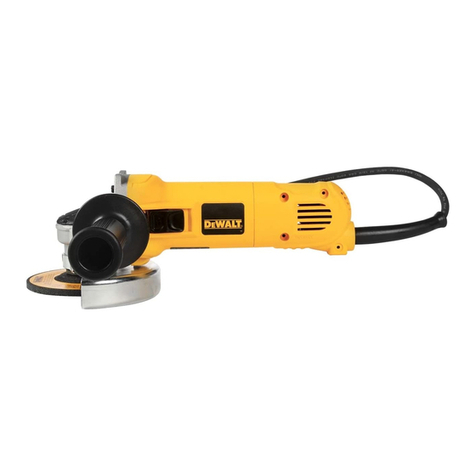
DeWalt
DeWalt DW400 instruction manual
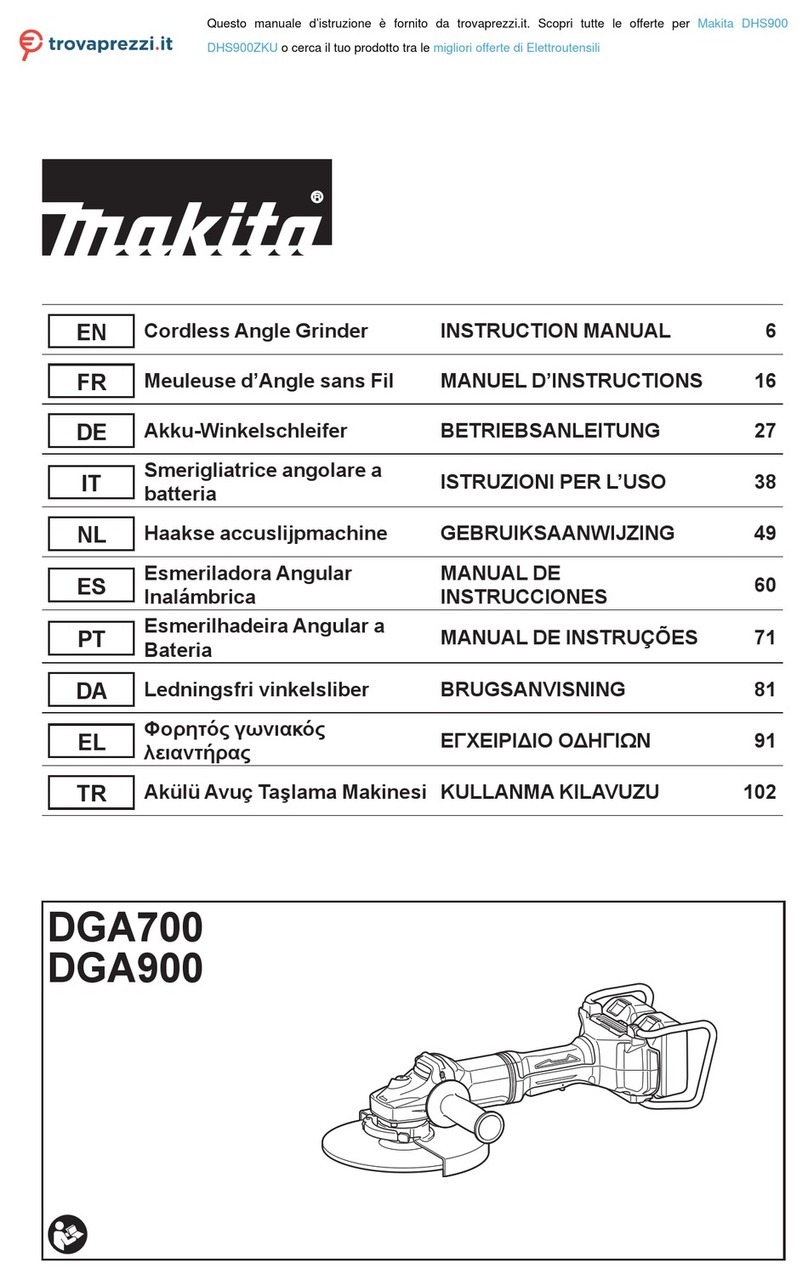
Makita
Makita DHS900ZKU instruction manual
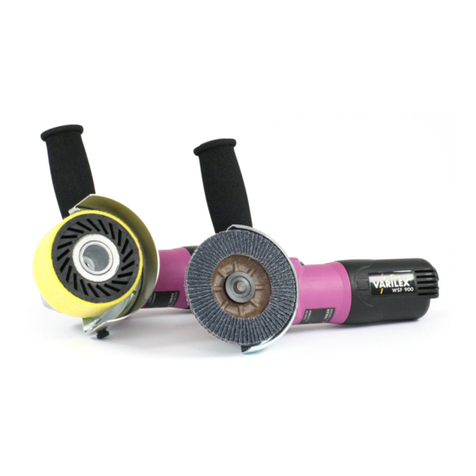
eisenblatter
eisenblatter VARILEX WSF 900 DUO operating instructions
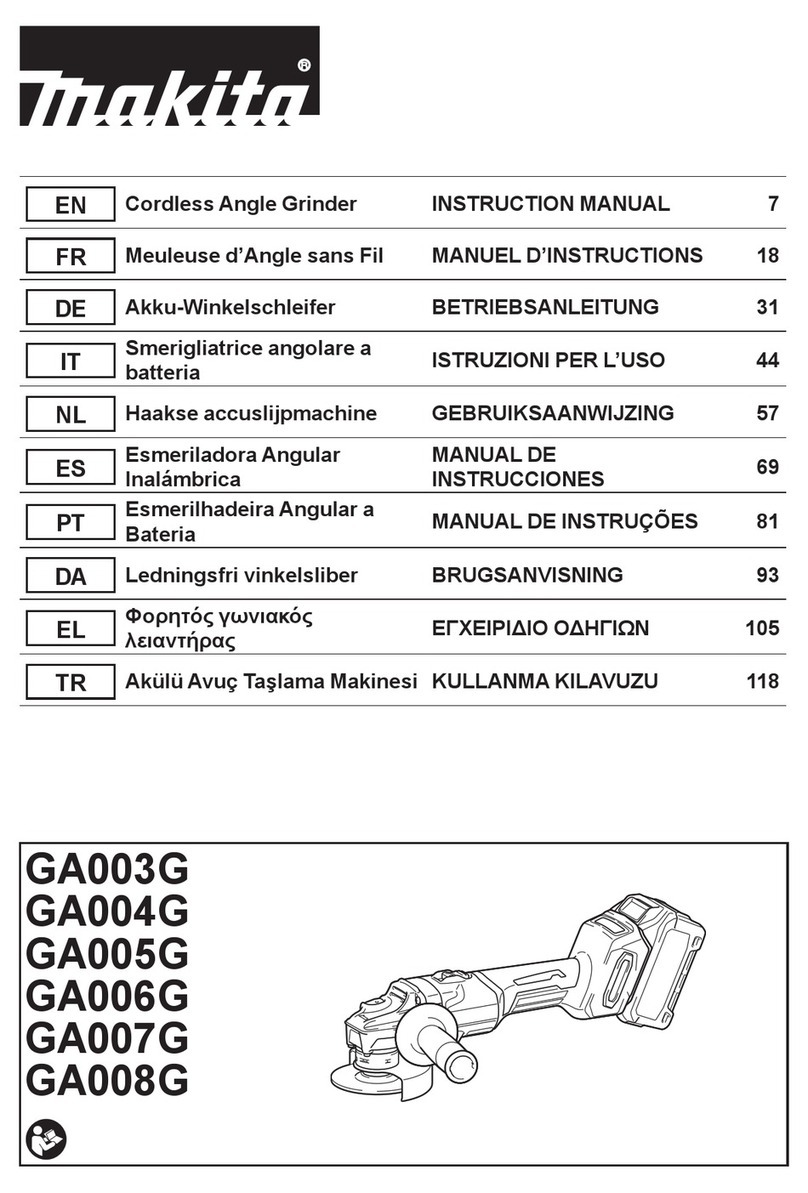
Makita
Makita GA006G instruction manual
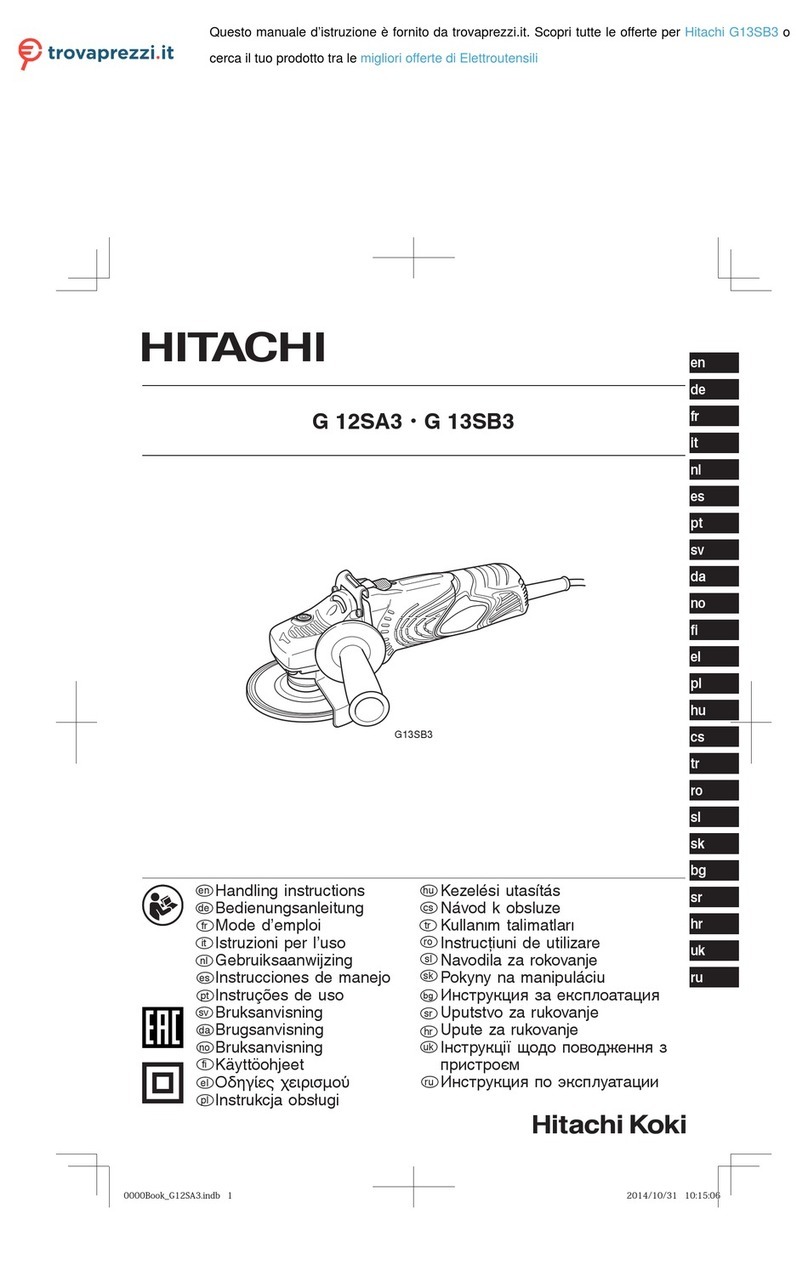
Hitachi Koki
Hitachi Koki G13SB3 Handling instructions

Parkside
Parkside PDFW 120 A1 Translation of the original instructions
